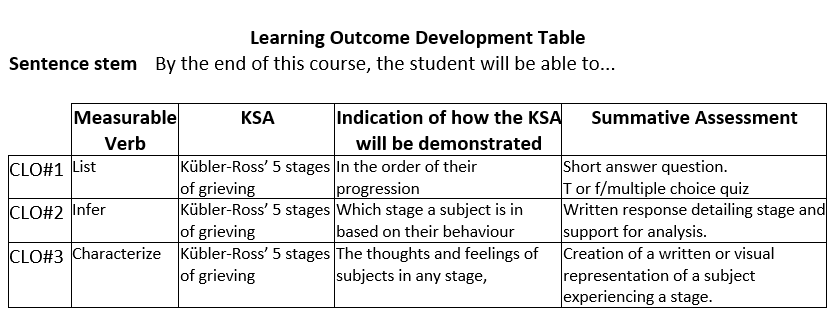Content Curriculum Map Matrix Documents
With all the factors influencing curriculum explored, discussed, agreed to and documented, the Curriculum Team is able to begin developing the content, also known as the Curriculum Map or the Matrix Document. Each curriculum map will be unique for the educational activity it documents curriculum for. Curriculum Maps are broad and complex documents, detailing as many essential aspects of curriculum as can be represented visually. Most complete Curriculum Maps will include the following:
These will be discussed in some detail below.
With an overall understanding of the context of the educational activity, the curriculum team is able to establish the content of the educational activity. In doing so, the Curriculum Team will begin to formalize the outcomes they want the graduates of the educational activity to demonstrate. In doing this, the Curriculum Team is developing the outcomes for their program, also called Program Learning Outcomes.
Program Learning Outcomes (PLOs) are learning outcomes from educational activities that occur at the program level. As learning outcomes describe a student’s ability upon culmination of an educational activity, all program level learning outcomes will speak to a student’s expected ability upon completion of a program of study. PLOs tend to be high level-learning outcomes. This means PLOs will not reference specific learning tasks or Course Learning Outcomes, but rather will speak to the graduate’s ability to synthesize and apply information available from multiple courses offered throughout the program to specific real-world situations.
Generally speaking, learning outcomes at the program level will be created before learning outcomes at the course or lesson level. Most people assume a specific number of outcomes for a program. A very general recommendation can be twelve PLOs for a degree, six PLOs for a diploma, and three PLOs for certificate, give or take two for each credential.
Program Learning Outcomes are an essential component of curriculum maps and are included in even the most basic of Curriculum Maps. They are located in the top row of the Matrix Document. Program Learning Outcomes, like all learning outcomes, describe how a learner will demonstrate or be assessed regarding a piece of knowledge, a skill, or an attitude (KSA) and the conditions and criteria of that assessment. It is highly recommended that the Curriculum Team constructing the Program Learning Outcomes document their ideas around the Assessment of the learning outcome during its creation. For more information on Program Learning Outcomes and how to create them, please see our Learning Outcomes Asynchronous Resource.
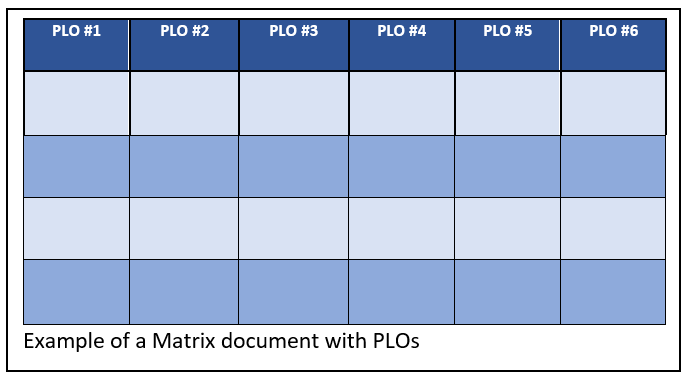
With the high-level outcomes established, the Curriculum Team begins identifying the core courses they feel will meet the Learning Outcomes for their program.
The identified courses are plotted down the far-left column and the associated Course Learning Outcomes one column to the right.
Course Learning Outcomes (CLOs) are learning outcomes from educational activities that occur at the course level. All course level learning outcomes will speak to a student’s expected ability upon completion of the course. Courses may appear at any level of the program. Some courses will introduce foundational material that other courses will reference and develop, and other courses will refine this material to an advanced state. It’s reasonable to assume that a student’s ability upon the culmination of a course with the material taught at the introductory or foundational level will be much less complex than a student’s ability with material taught at an advanced level. For this reason, Course Learning Outcomes are more challenging to create than Program Learning Outcomes. When creating a Course Learning Outcome, the Curriculum Team must be deliberate in assessing the level of complexity of the course and where it will appear in the program.
As with PLOs there are no set number of CLOs required for a course. Quality is more important than quantity in this case, and Subject Matter Experts (SMEs) may use five CLOs per course, give or take 2 as a general target. CLOs tend to be very aligned with the summative assessments for a course. Some Curriculum Teams will develop their assessments alongside the development of their outcomes to ensure this alignment. When developing a curriculum, Program Learning Outcomes are generally developed first, followed by Course Learning Outcomes. When it comes time to assess a curriculum for quality, the curriculum is often assessed based on the intersection between the Course Learning Outcomes and the Program Learning Outcomes. These intersections are a critical component of Curriculum Mapping.
Course Learning Outcomes are another essential component of a Curriculum Map and are included in even the most basic of curriculum maps. They are located with the course titles in the far-left columns of the Curriculum Map. Course Learning Outcomes, like all learning outcomes, describe how a learner will demonstrate or be assessed regarding a piece of knowledge, a skill, or an attitude (KSA) and the conditions and criteria of that assessment. It is highly recommended that the Curriculum Team constructing the Course Learning Outcomes document their ideas around the assessment of the learning outcome during its creation. For more information on Course Learning Outcomes please see our Learning Outcomes Asynchronous Resource.
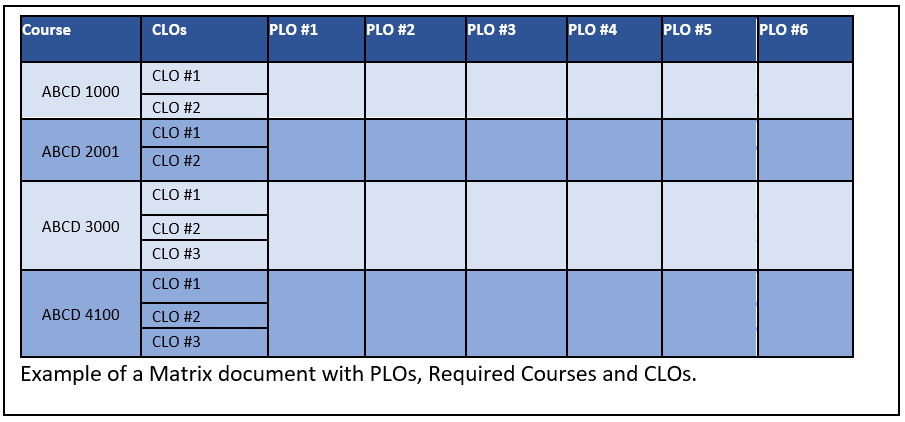
With the first draft of the program learning outcomes documented across the top of the Matrix Map, the courses with their associated Course Learning Outcomes documented in the two left columns, the Curriculum Team is in a position to identify intersections between the Course Learning Outcomes and the Program Learning Outcomes.
The Curriculum Team will review each individual Course Learning Outcome against each Program Learning Outcome. If the Course Learning Outcome supports or in some other way relates to the Program Learning Outcomes, then the intersection of the Course Learning Outcome and the Program Learning Outcome will be marked with an “X”.
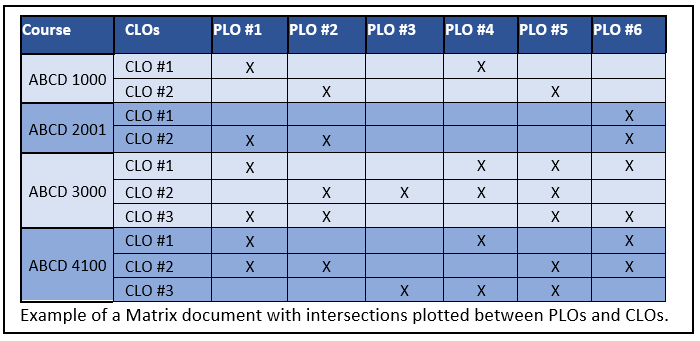
Once assessed the curriculum team will assess the same Course Learning Outcome against the next Program Learning Outcome. This will continue until the Course Learning Outcome has been assessed against all of the Program Learning Outcomes. Once complete the Curriculum Team will move on to the next Course Learning Outcome and begin the process of assessing that against each of the Program Learning Outcomes. This process continues until all the Course Learning Outcome’s have been exhausted. This map of intersections between the Program Learning Outcomes and Course Learning Outcomes is called a Basic Curriculum Map.
The purpose of the Basic Curriculum Map is to determine how well the Program Learning Outcomes are represented or supported by the course choices. Will the courses selected support the achievement of the Program Learning Outcomes? With the Basic Map completed, the Curriculum Team can begin evaluating the intersections to determine how well supported the Program Learning Outcomes are. The Curriculum Team is looking for:
Gaps – a lack of or a lower than expected number of intersections for any Course Learning Outcome or Program Learning Outcome.
Redundancy – too many intersections for any Course Learning Outcome or Program Learning Outcome.
If the Curriculum Team finds Program Learning Outcomes with gaps, they may question the wording, structure, or content of the Program Learning Outcome. If it is not well-intersected then the Learning Outcome may not truly be reflective of the program’s intentions and needs rewording or rethinking. If the Curriculum Team find gaps for Course Learning Outcomes, they may question if the course chosen is correct to meet the intentions of the program, or they may choose to rework the Learning Outcomes for the course to be better aligned with the Program Learning Outcomes.
If the Curriculum team finds a Program Learning Outcome is over represented by intersections with Course Learning Outcomes, then the Program Learning Outcome may be too broad, requiring revision. If the Curriculum Team finds a Course Learning Outcome that is over-represented, they may wish to review and possibly revise the course outline. With this first map comes the first opportunity to check the validity and accuracy of the Learning Outcomes for the program. It is unlikely that the Curriculum Team will be successful with the first iteration of their basic map, and will need to rethink, rework, and revise some of their ideas. These iterations, changes, and rationale for the changes should be recorded and included in the Context Document.
IMPORTANT POINT: Explicit Vs Implicit Intersections
With the intersections identified, and any gaps or redundancies revised or explained, the Curriculum Team is able to determine how the intersections express the Program Learning Outcomes. That is, do the Course Learning Outcomes at each intersection explicitly support the Program Learning Outcome, or do they implicitly support the Program Learning Outcome? To do this, the Curriculum Team will review each intersection and determine if the Course Learning Outcome is explicit or implicit in the support of the Program Learning Outcome. For example, a Program Learning Outcome that articulates a graduate’s ability to work in teams may be explicitly supported by a Course Learning Outcome from a course on Project Management. The content required to achieve the Course Learning Outcome may include “determining or leading team roles on projects” which explicitly supports the Program Learning Outcome of “ability to work in teams”. The same Program Learning Outcome may be implicitly supported by a different course’s Learning Outcome with unrelated content presented through a group project. This unrelated course content presented through a group project will implicitly support the achievement of the graduate’s “ability to work in teams”. If the Curriculum Team determines an intersection to be implicitly supported, then they will change the “X” to an “M” for IMPLICIT. If the intersection is determined to be explicitly supported, then the “X” will remain for EXPLICIT.
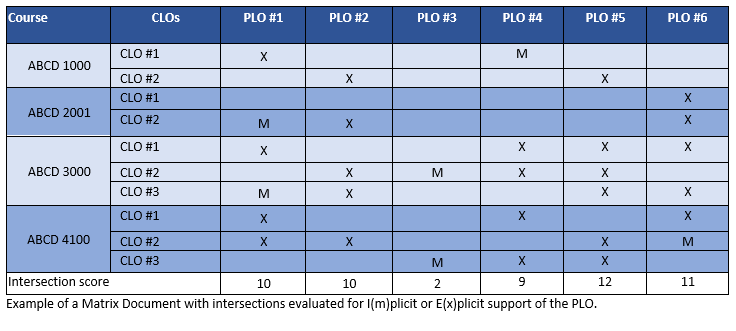
Once complete, the Curriculum Team can total the intersection score for each Program Learning Outcome. As explicit support is clearer than implicit support, each “X” will be given a score of 2 and each “M” will be given a score of 1. The resulting scores will provide a relative value for the support of each Program Learning Outcome. The Curriculum Team may review the Curriculum Map for Gaps and Redundancies as denoted by the intersection scores. There is no correct answer or range of scores that will determine if a Curriculum Map is correct or not. This is simply a tool to help identify outliers and allow the Curriculum Team an opportunity to correct or explain them.
Some educational activities, disciplines or programs are more suited to this type of analysis than others. The Curriculum team should have a discussion of whether to pursue this analysis, why or why not and document the results in the Context Document.
Once the Curriculum Team has created an iteration of the Curriculum Map with no gaps or redundancies that they feel confident with, they are ready to consider adding the imposed competencies to the Basic Curriculum Map.
In the previous section we discussed Imposed Factors in some detail. As a reminder these are influences from the different sites and types (Olivia link to page 84 – sites of curriculum) of curricula that result in a direct imposition on the content of the curriculum, and must be represented within the Curriculum Content Matrix to demonstrate achievement. Some of these factors will be true outcomes as defined in our Learning Outcomes Asynchronous Resource, and others will merely denote the occurrence of the required factor. Regardless of their form or function, these Imposed Factors will be represented in either the Program Learning Outcome row or the Course Learning Outcome column. It is important for the Curriculum Team to assess the most accurate placement for representing these Imposed Factors in a curriculum map.
Tip:
To help with identifying the intersections:
As stated above Course Learning Outcomes tend to describe a demonstration of a learner’s ability tied to a practical assessment and relevant instructional activity. Program Learning Outcomes on the other hand are a broad description of a graduate’s ability upon culmination of their program study that is demonstrated over time in their career or future studies outside of the Program being Mapped. The statements use very different language that can be challenging to reconcile.
To make this process easier, the curriculum Development team may choose to include an additional row of cells below the Program Learning Outcomes. Key content, descriptions and examples of Course Learning Outcome language that supports Program Learning Outcomes can be put into these cells and provide clarity to the scope and limitations of each corresponding Program Learning Outcome.
Please see an example below.

Factors included in the Program Learning Outcome (PLO) row will be assessed against each Course Learning Outcome in the curriculum. The PLO row is particularly useful for measuring:
- Imposed factors directly related to a specific course or discipline. For example, the occurrence of a Q/A course, or a requirement for 6 credits of ENGL.
- The progression of development for a topic or skill. For example, required fitness benchmarks throughout a Human Kinetics program.
Factors included at the Course Learning Outcome level will only be assessed against the three, six or twelve Program Learning Outcomes, depending on the credential awarded upon completion of the educational activity. As there are so few outcomes to verify the factors against, the Course Learning Outcome column is best for documenting the occurrence of a specific Knowledge, Skill, or Attitude by the end of the academic activity. For example, the Essential Skills outlined by the Ministry would be best represented in the CLO column and measured by the intersection with the relevant PLO.

IMPORTANT POINT: Faculty or Department Imposed Factors
If the imposed factors include a series of courses required by the Faculty or Department level, for example, a shared foundation selection of courses, then the Curriculum Team may include these at both the CLO and PLO levels. The Curriculum Team may include the required courses below the educational activity courses. In some cases, these selections of courses have associated faculty level learning outcomes, and in other cases they have no learning outcomes. If learning outcomes exist for these courses, then these may be included next to the Program Learning Outcomes for the educational activity. The Curriculum Team is then in a position to plot the intersections of all the course learning outcomes against the program learning outcomes for both the faculty requirements and the educational activity. This will allow the Curriculum Team to assess for any gaps and redundancies between the educational activity and the imposed department/faculty factor.

Once the intersections have been assessed for Gaps and Redundancies, the Curriculum Team may review the intersections for implicit or explicit support of Program Level Learning Outcomes. It is best for the Curriculum Team to be consistent with their previous choice, and assess the support of imposed factors if they have assessed the support previously. If the Curriculum Team chose not to assess for support of Program Level Learning Outcomes, then it is prudent to bypass assessment of imposed factors as well.
Again, the Curriculum Team determines the most appropriate way of representing these requirements, then documents the decision and rationale in the context document.
The basic map is effective for basic purposes. Curriculum Maps are much more informative and useful when the level or complexity of the intersections have been evaluated. There are many Curriculum Map evaluation frameworks available and each function in a very similar manner: to identify the level of complexity represented by the intersection of the Course Learning Outcome with the Program Learning Outcome.
Stated another way, the previous content explored if Program Learning Outcomes were supported by Course Learning Outcomes, the Map Evaluation Framework explores how Program Learning Outcomes are supported. Is the content that supports the Program Learning Outcomes organized in a manner effective for learning? The framework this resource will explore is the IDA framework.

IDA is an acronym for Introducing, Developing, and Advancing. To apply this framework, the Curriculum Team reviews each intersection identified in the previous sections and determines if the content of the Course Learning Outcome is Introducing, Developing, or Advancing the Program Learning Outcome. Once determined, the Curriculum Team places a corresponding I, D, or A in a cell under the Program Learning Outcome, next to the cell indicating the Explicit/Implicit Statement of the Program Learning Outcome.
Once each intersection has been identified as Introducing, Developing or Advancing the Program Learning Outcomes, the Curriculum Team may examine the map for gaps, redundancies and misalignments. Similar to the earlier assessment, these are:
Gaps – a lack of or a lower than expected number of “I”, “D”, or “A”s intersections for any Program Learning Outcome.
Redundancy – too many “I”, “D”, or “A”s intersections for any Course Learning Outcome or Program Learning Outcome.
Misalignments – “A” appearing before “D” or “D” appearing before “I” represents a misalignment of content.
Going through this process allows the Curriculum Team to measure if Program Learning Outcomes are being Introduced, Developed and Advanced appropriately. Where inconsistencies, or outliers exist, the Curriculum Team can address and revise, or provide an explanation for the content. Any description or rationale must be documented in the Context Document.
There is no correct number of “I”, “D” or “A” to attain. In general, Program Learning Outcomes are expected to occur with “I” preceding “D” preceding “A”, and there should be at least one Explicit support of each PLO at the “I” level. If the Curriculum Team has a rationale for why the format deviates from the expectation, all that is required is to document the rationale. This process is intended to make the content order visible and provide the Curriculum Team with an opportunity to review the content. With this level of content defined, evaluated and recorded, the Curriculum Team is able to turn its attention to other critical curriculum components.
Most of the content this resource has discussed has been focused on learning outcomes, how they intersect, whether they support each other explicitly or implicitly, and the complexity of their intersection. While learning outcomes are critical to curriculum and curriculum mapping, there are two other components that need to be included in a curriculum map. These are:
- Assessments
- Instructional Activities
These three components taken together are so central and important to curriculum that they are guided by several theoretical and practical approaches. This resource will explore two in particular:
Constructive Alignment
John Biggs first posited the idea of Constructive Alignment. Constructive Alignment outlines three key components for any learning activity. These key components are:
- Learning Outcome – Demonstratable goal of the Learning activity. What the student will be able to do know or feel as a result of the lesson, course, program, etc.
- Planned learning activity – The format and method for delivering the educational material that will lead to the student meeting the planned and communicated outcome.
- Planned assessment – the format and type of assessment to determine that the learning articulated in the goal has been achieved
Biggs (2003) felt that these three components influenced and were influenced by each of the other components. More importantly, each of these components needs to align with the other components. For more information on Constructive Alignment, please see our Learning Outcomes resource. Learning Outcomes Resource.
Backward Design
Recognizing that all three components, (the intended learning outcomes, the learning activities, and the intended assessments) are important, influence and are influenced by each other leaves an obvious question – “where do we start?”. Wiggins and McTighe (2005) suggest that an effective approach to instructional design is to start with the end goal, also called Backward Design.
The first step in Backwards Design is to identify the desired results. What are the big ideas and skills that a student should know, do, or feel and how do they demonstrate this learning? These are also known as the Learning Outcomes
The next step is to determine acceptable levels of evidence that suggests that learning has occurred. What culminating assessment tasks are needed to provide evidence that the intended learning has taken place?
Finally, the instructor designs learning activities that seek to achieve the identified learning outcomes and will support the student to complete the assessment successfully. What are the necessary learning events?
The merits of this approach are that it is deliberately thought out to identify goals, identify assessment of those goals, and develop activities that will support achieving those goals. In this way, it comes much closer to achieving the instructor’s vision of student ability and their demonstration of that ability. For more information on Backward Design, please see our Learning Outcomes Asynchronous Resource.
Constructive Alignment outlines the importance of learning outcomes, assessments, and instructional activities, and their alignment as foundational for an effective curriculum. Backwards Design shows the order to approach these foundational components. This resource has addressed Learning Outcomes, the first component, in some detail and will explore the others in order.
Course Outlines are documents that presents key information regarding the course, its structure, duration and intentions. This contrasts with the Course Syllabus, which is a document that details key information regarding a specific iteration of a course, usually with dates, times, and locations included. Different terms are used to describe a Course Outline, including Course Presentations, Course Descriptions, and Course Prospectus, and for the purpose of this resource, the term Course Outline will be used.
Course Outlines exist for all types of courses. Informal courses will often have a truncated description outlining structure, duration, and intentions, while more formal settings like K-12, College, and Universities will include official Course Outlines that detail information required by the institution, the department, the program, and any regulating organization as well as learner-centric information around course structure, duration, and intentions. Some of this more formal information includes:
- Official Course Title
- Official Course Number
- Official Course Name
- Official Course Description
- Academic Level
- Faculty
- Department
- Implementation Date of Current Iteration
- History of Previous Iterations
- Subject Code
- Descriptive title
- Short title
- Credits
This more formal Course Outline information is often documented in formal policies. As an example, Kwantlen Polytechnic University’s Policy AC4 and accompanying Procedure defines Course Outlines, their purpose and scope as follows”
“Course Outline: The official description of a course taught at KPU. Each active course must have an up-to-date, Senate-approved course outline. Course outlines serve four purposes:
- They contain the learning outcomes, content, learning activities, assessment methods, and other curricular information that ensures consistency among instructors.
- They are used for establishing transfer credit articulation agreements with other institutions.
- They represent an agreement that the instructor, as a representative of the University, will provide students with a particular learning experience.
- They outline the conditions for enrolment and academic credit.”
These more formal Course Outlines often represent a legally binding document; a contract between the learner and the institution detailing what will be covered by the course. They also include information that is important for Curriculum Teams and educators implementing a curriculum to consider. Some examples of this include:
Instructional Activity Distribution – where or how the course was planned to be offered? In class, in a lab, or online etc. This is an important consideration as courses planned for one setting may require different practices, planning or scaffolding to optimize the content for other settings.
Prerequisites – what course work must be completed before a learner is able to take the existing course? This helps identify the content that needs to be completed in advance for a learner to be successful in achieving the Course Learning Outcomes.
Corequisites – what coursework must be undertaken simultaneously for a learner to be able to take a course? This identifies the content, often too broad in scope for one course, that must be taken concurrently for the student to successfully achieve the Course Learning Outcomes.
While this information does exist in most formal Course Outcomes, it is helpful for Curriculum Teams to consider and essential for educators implementing a curriculum to apply, in delivering an effective educational activity, this information is not essential for a Curriculum Content Matrix. The Information from a Course Outline that is essential for the Curriculum Content Matrix is the previously discussed Course Learning Outcomes and Assessments. What hasn’t been covered is Course Content. Course Outlines may organize Course Content in different structures, from completely flexible and informal, through to rigid and prescribed. Some examples include:
SUMMARY
The different content structures and identification discussed all have different strengths and challenges associated with them. It is important to note that adopting one structure does not exclude the other structural options. It is recommended that the Curriculum Team use as many of these content options as possible when developing Course Outlines and when using these Course Outlines to populate the Curriculum Content Matrix. Using multiple structures will gain the cumulative identified benefits while ameliorating the challenges associated with individual structures.
It is strongly recommended that the Curriculum Team Developing the Curriculum Map consider and integrate as much of this content as they feel is necessary. For some of the more rigid and prescribed programs, this option will be mandated, and for other programs this represents an opportunity to provide a clearer record, and more transparent guidelines for future colleagues implementing the curriculum. For Curriculum Teams considering developing relevant Lesson Learning Outcomes, a sub Curriculum map that assesses the alignment of the Lesson Learning Outcomes with the Course Learning Outcomes can be helpful. see below for an example.
NOT INCLUDED IN THE CURRICULUM MAP MATRIX DOCUMENT
The preceding section has described various items components and considerations to include in a Curriculum Content Matrix. At its most basic, the Curriculum Content Matrix documents factors that support the Program Learning Outcomes identified by the Curriculum Team. Anything that doesn’t support the Program Learning Outcomes or is not an imposed factor does not need to be included in the Curriculum Content Matrix. This does leave room for subjectivity by the Curriculum Team. One topic that comes up regularly regarding inclusion are electives.
